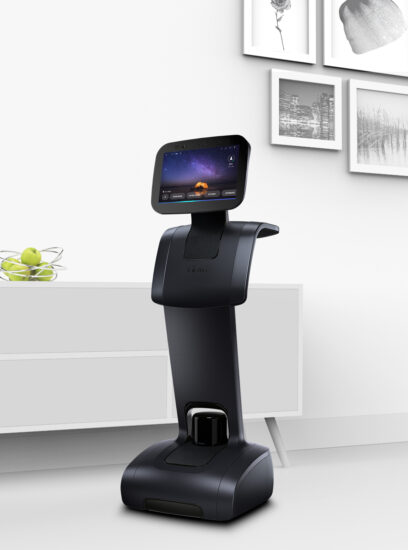A&M-Commerce Faculty Hope Assistive Robot Can Provide Human Connection

As social distancing requirements surrounding the COVID-19 pandemic have shifted the way we interact with the world around us, researchers at Texas A&M University-Commerce are seizing the opportunity to further their research into the connection between humans and robots.
Dr. Rebecca Judd, associate professor and department head for the School of Social Work, and Dr. Chris Jones, lead web application developer in the Center for IT Excellence, have placed a service robot at Legacy Assisted-Living & Memory Care in Denison, Texas. They hope the robot, named Temi, will help isolated residents communicate with loved ones outside of the facility.
“Assistive robots offer a unique opportunity to make a difference in the lives of vulnerable populations,” says Judd. Many long-term care patients are unable to utilize smart phone technology due to physical or cognitive disabilities.
Standing just over 3 feet tall, Temi is a robot on wheels with a ten-inch touchscreen display used to interact with humans. The robot can identify, understand and respond to voice commands. It can navigate through hallways, remember room locations and maneuver effortlessly around obstacles in its path. It can check the weather, play music or even tell a joke.
Residents can use voice or touch commands to video conference with their family members through Temi's digital display, which is visually similar to a tablet computer. When a call is received, Temi can steer its way to the resident's location while the caller looks on through the built-in camera. Callers can spend time with their loved ones, almost as if they were actually in the room. Temi can follow the resident during the call, and return home to its power base afterward to recharge.
“Social work is based on human relationships; we can learn to deploy the robots in ways to improve the overall human condition,” Judd continued. “Whether it's helping a family member make meaningful contact with a loved one during the current pandemic, or placing robots in schools to help children with special needs overcome daily challenges.”
Temi has the ability to do much more during its time at the assisted-living facility. Temi can assist the staff as they monitor and care for the residents. It can roam hallways autonomously, check in on patients and get help if needed. The unit can also be steered by staff members through an app. Soon, Temi will be able to record a patient's vitals and update their records by connecting to peripheral devices such as thermometers, weight scales and blood-pressure cuffs.
Jones says the possibilities are endless. He collaborates with the company in California that produces Temi, and estimates there are roughly fifteen-thousand Temi units worldwide. They're all connected to a cloud-based neural network, so they learn from each other as each unit experiences and overcomes new challenges. A Software Development Kit (SDK) is available so that developers like himself can program Temi for other functions.
“It's an autonomous computer on wheels and it's a blank slate,” said Jones. “That's perfect for developers because we can make them do anything we want them to do. The sky is the limit.”
He says the robots can be used for a wide range of purposes in homes, businesses, stores and restaurants, universities, libraries and museums, and the hospitality industry.
Jones hopes to see more Temi robots around campus. He believes, as universities and schools begin to embrace artificial intelligence robots like Temi, people will find it easier to interact freely with technology.
“This is where we're moving to,” Jones says. “We're integrating technology with people, and this is how easy it is to interface with these technologies.”


